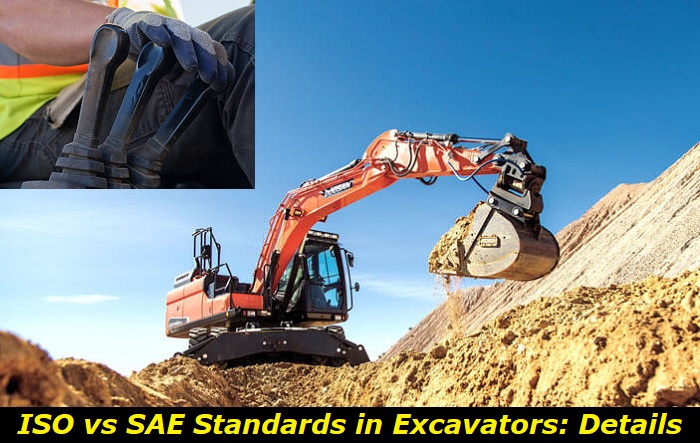ISO vs SAE Controls in Excavators - History, Features, and Some Key Advantages
Excavators, like all earthmoving machinery, are essential for building and landscaping. Excavators are incredibly versatile machines with a variety of possibilities, despite being frequently associated with digging foundations. Excavators can complete a variety of standard and specialized work site tasks thanks to a wide range of compatible work tools.
If you happen to be buying your first excavator or you are a novice when it comes to this, you may be left scratching your head when you hear about ISO vs SAE controls. In this article, we will guide you on these two types of controls implemented for excavators worldwide so you will have a good understanding of what they are all about.

Two Types of Excavator Controls
As the construction industry began to grow and evolve in the early 20th century, the need for standardized procedures and controls became apparent. In response, various organizations developed standards for excavator operations. The most well-known of these are the International Organization for Standardization (ISO) and the Society of Automotive Engineers (SAE).
ISO is a global organization that is responsible for the crafting and issuance of international standards. ISO standards are voluntary agreements that are designed to be used by businesses, governments, and other organizations around the world.
SAE is a professional association for engineers and other technical experts in the automotive industry. SAE standards are developed through a consensus process involving industry experts from around the world.
Both ISO and SAE have developed standards for excavator operations. These standards specify the minimum requirements for excavator safety, design, performance, and operations. They are used by manufacturers to ensure that their products meet the necessary safety, performance, and operational standards.
The subject of excavator controls in the protocols defines the procedures that a person using heavy equipment, such as a backhoe or an excavator, uses to operate the digging components (such as the swing, boom, stick, and bucket).
Nowadays, the types of controls normally applied for excavators have been streamlined to ISO and SAE controls. This part will provide a quick comparison of the two providing you with their short history and features.
1. ISO Controls
The ISO is an unaffiliated, non-governmental organization established in 1947. Different national standards bodies make up its roster. As of 2022, there are 167 members representing ISO in their nation, with each nation only limited to a single member.
With the exception of electrical and electronic engineering, which are the purview of the International Electrotechnical Commission (IEC), the organization develops and publishes international standards in all technical and nontechnical fields. Over 24,261 standards have been created by the ISO as of April 2022, covering everything from manufactured goods and technology to automotive, food safety, agriculture, and healthcare. There are 804 technical committees and subcommittees within ISO that work on further developing and harmonizing international standards.
Utilizing the revised versions of the SAE J1177 and ISO 10968 as bases, the one simply referred to as "ISO controls" is the control pattern that is most frequently used globally. As a recap, the SAE J1177 protocol was put in place in 1978, and from then on, it went through a series of reaffirmations and revisions until it stabilized in 2019. Meanwhile, the ISO 10968 protocol was introduced in 2004 but was later withdrawn to adopt the 2020 version of the standards.
In comparison to SAE, the ISO control pattern has the right-hand joystick controlling the Main Boom (up and down) as well as Bucket motions (close and dump) while the left-hand joystick controls the Swing (left and right) and the Stick Boom (away and close).
The rest of the controls are the same as the ones followed by SAE. Therefore, the resulting ways to operate the joystick under ISO controls are:
- Pushing the left-hand joystick to the left swings the excavator to the left while taking the left-hand joystick to the right swings the machine to the right.
- Driving the left-hand joystick forward puts the Stick Boom (Dipper) away while pulling the left-hand stick back closes it.
- Operating the right-hand joystick to the left takes the Bucket to curl in (closed) while taking the right-hand joystick to the right curls it out (dump).
- Putting the right-hand joystick forward positions the Main Boom down while pulling the right-hand joystick back raises it.
2. SAE Controls
Formerly known as the Society of Automotive Engineers, SAE International is a US-based, internationally active professional association and organization that develops standards for engineering professionals working in a variety of industries. It was founded in 1905 and has since grown in influence over the years.
Global transportation sectors like aerospace, automotive, and commercial vehicles are given priority under this organization. The company changed its name to SAE International to better reflect its expanded focus on worldwide mobility.
The total membership of SAE International is over 138,000. Rather than corporations, individuals are given membership. SAE International invests money in projects and programs for STEM education, professional certification, and collegiate design competitions in addition to its standardization efforts.
Companies, governmental organizations, academic institutions, and consultants can collaborate in SAE International's forum to develop technical standards and suggested procedures for the development, manufacturing, and characteristics of motor vehicle components. Although they have no legal standing, SAE documents are occasionally cited by the United States. Administration for National Highway Traffic Safety (NHTSA).
One of the most widely used control patterns in the US, along with ISO, is the one called "SAE controls". The only way SAE controls are different from ISO controls is that the boom and the joystick are controlled by different hands. In J1814, this control pattern is standardized.
The J1814 protocol was issued in 1993. It has undergone reaffirmation in 2003, revision in 2012, and stabilization in 2020.
In the SAE control pattern, the right-hand joystick controls the Stick Boom (away and close) and Bucket motions (close and dump). On the other hand, the left-hand joystick controls the Swing (left and right) and the Main Boom (up and down).
The rest of the controls are the same as the ones followed by ISO. Therefore, the resulting ways to operate the joystick under SAE controls are:
- Taking the left-hand stick to the left direction swings the excavator to the left while putting the left-hand stick to the right swings it to the right.
- Pushing the left-hand joystick forward puts the Main Boom down while pulling the left-hand joystick back raises it.
- Operating the right-hand joystick to the left curls the Bucket in (closed) while moving the right-hand joystick to the right curls it out (dump).
- Driving the right-hand joystick forward takes the Stick Boom (Dipper) away while taking the right-hand joystick back causes it to close.
ISO vs SAE Advantages
To our understanding, ISO and SAE both claim to have optimized their respective controls based on human anatomy, muscle memory, productivity, and many other factors. In actuality though, there are no significant advantages brought upon by one type of control over the other.
In the end, the optimization of the performance of both the machine and its operator all boils down to the familiarity and preference of the latter. If the operator has been used to working in foreign soil dominated by excavators possessing ISO controls, then the person will tend to perform effectively and efficiently with the said controls. The same can be said for an operator who has been used to working with excavators in North America that are standardized under SAE controls.
Changing the Control Pattern of Excavators
Back in the day, changing the control pattern of an old excavator required accessing the control valve assembly or junction box to replace the four pilot hoses used to manage the controls. This can be a very time-consuming and messy task.
Due to the advancement of technology in this era though, some excavators now come with modes that let operators switch between ISO and SAE controls. This convenient feature aims to tailor to their varying experiences and preferences with each type of control, which would later translate to their productivity.
An example of this is the program offered by the present selection of John Deere rental equipment. The process can be accomplished using these simple steps:
- Look under the seat for the pattern control changer.
- Use the key to open the box.
- Remove the bolt that is securing the lever.
- To alter the pattern from SAE to ISO or vice versa, simply turn the lever to your preferred type of control.
- Put back the bolt holding the lever in place to protect it from strong vibrations during the operation of the machine.
- Lock the box again.
The procedure is easy to follow and can be repeated as often as necessary on all current John Deere excavators to accommodate various operators and their individual control preferences on a job site.
The process varies from one excavator to another depending on the make, model, or layout of the controls. However, the one shown here simply illustrates how easy it is to shift from ISO to SAE or the other way around if implemented properly in an excavator.
Conclusion
To wrap things up, SAE controls are the standard in the US and Canada while other parts of the world mostly employ ISO controls. The difference mainly lies in how the functions of the left hand forward and back as well as right hand forward and back controls have been interchanged.
Other than that, everything is the same in terms of function and advantages. Luckily, some new excavators now come with ways to switch between ISO and SAE for the convenience of operators, so this should no longer be a big deal for everyone going forward.

Add comment